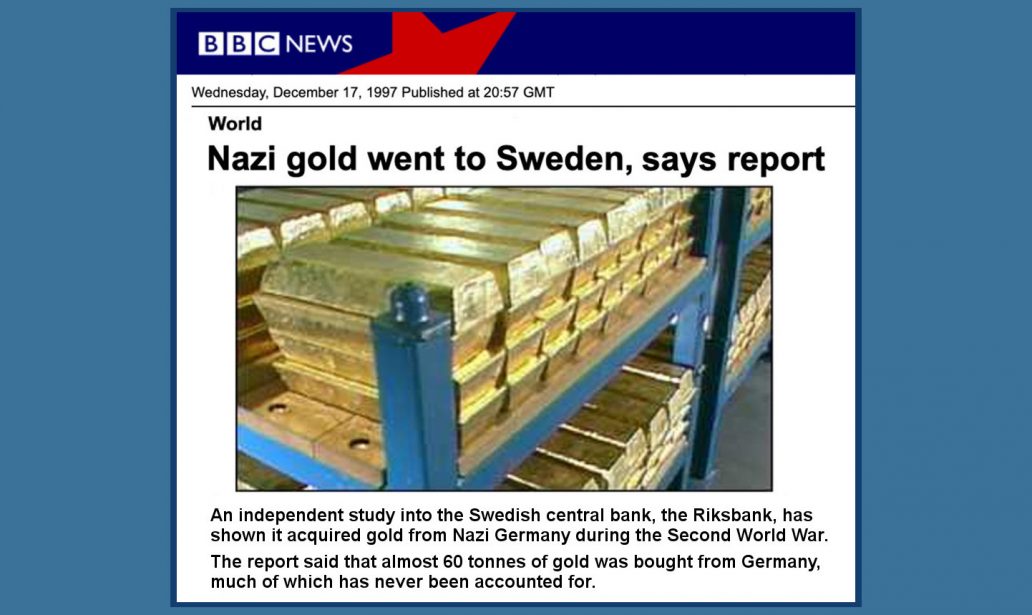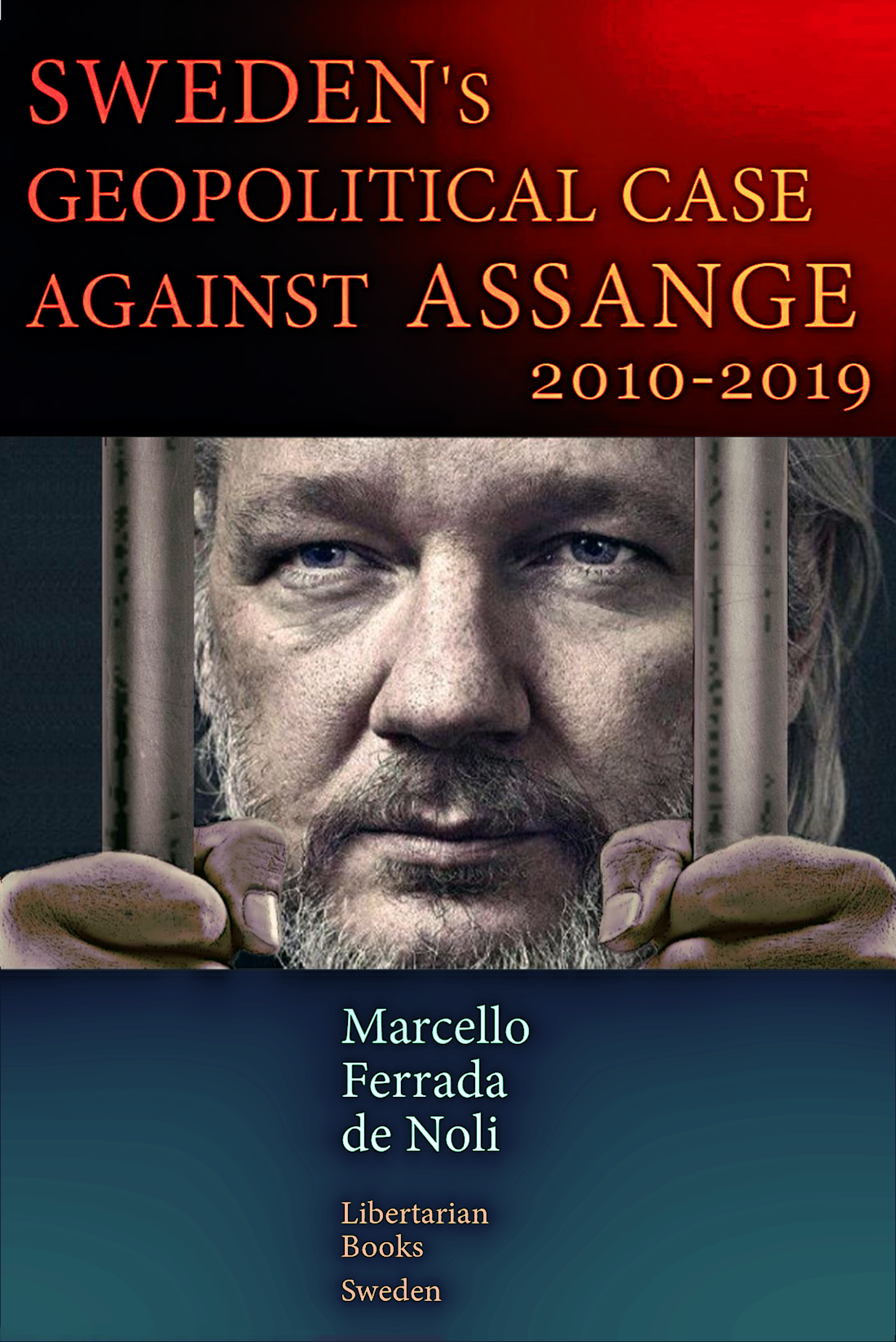By Prof. Marcello Ferrada de Noli
Carl von Clausewitz established a dialectic paradigm where an actual war it is said to include not only political aims, but also political means. In my interpretation, that would constitute the modern theoretical frame in the practice of applied geopolitics by powers and client states.
“War is a mere continuation of policy by other means”. This classical axiom –formulated by the Prussian general Carl von Clausewitz– is complemented by other, less known wisdom remarks found in his opus “On War” (1832). [13]
Epic illustrations of such inspiration are not only found in the Prussians, or in Hitler’s strategy of an expansion of the Third Reich into the European geographic/economic scenario.
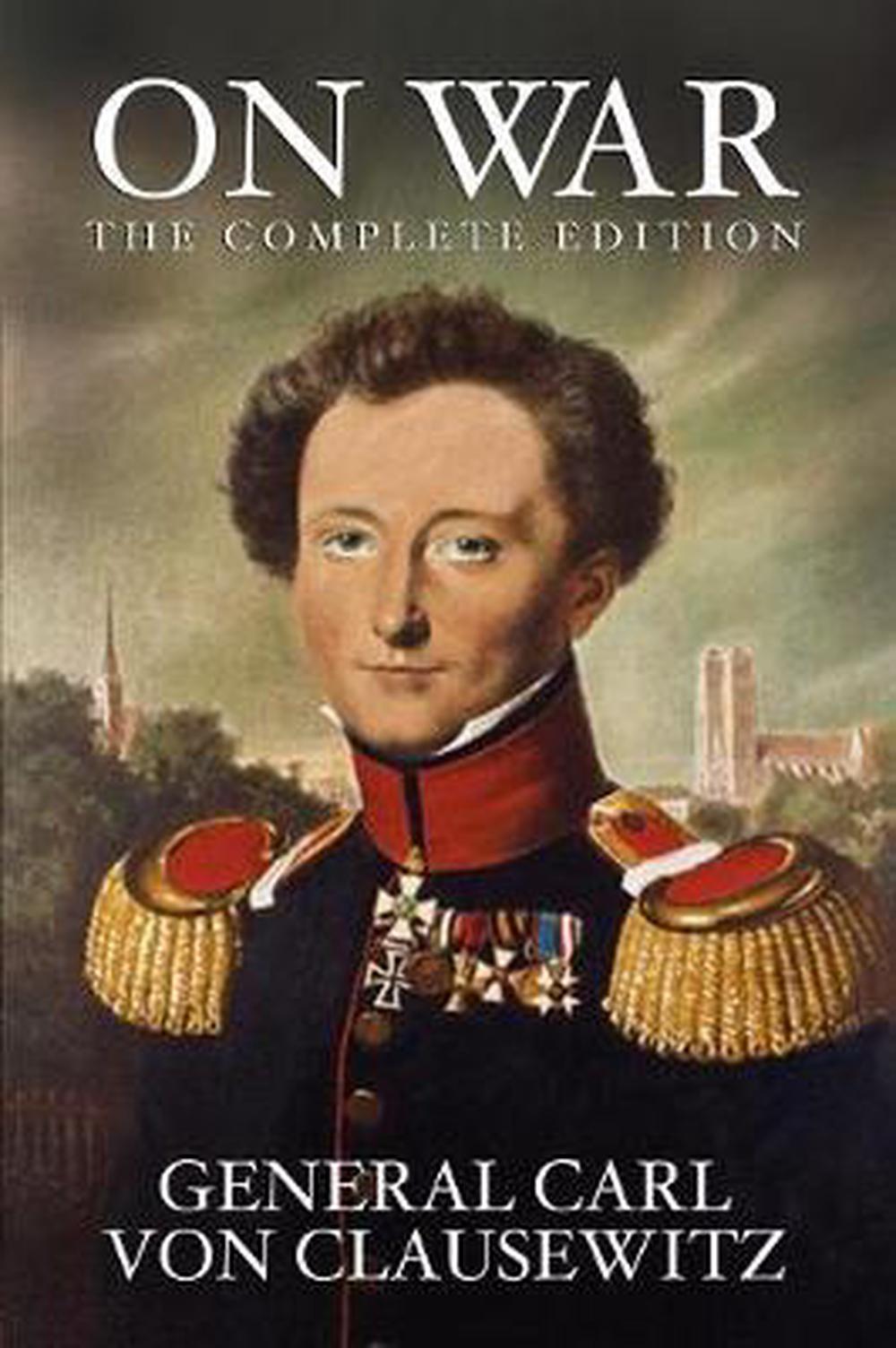 Clausewitz notions of organized violence as means for implementation of structural system-change politics (e.g. revolutionary insurrections), was as well widely popular in insurrectional circles all along from Frederic Engels times around the 1840’s, to the past century’s Latin-American revolutions –less victorious than failed, less attempted than dreamed. As a matter of fact, even we –me included– quoted Clausewitz in our revolutionary documents of the 60’s. [14]
Clausewitz notions of organized violence as means for implementation of structural system-change politics (e.g. revolutionary insurrections), was as well widely popular in insurrectional circles all along from Frederic Engels times around the 1840’s, to the past century’s Latin-American revolutions –less victorious than failed, less attempted than dreamed. As a matter of fact, even we –me included– quoted Clausewitz in our revolutionary documents of the 60’s. [14]
In an ample characterization, the use of “Neutrality” as tool in geopolitics may serve to reach ends similar to those obtained by warfare.
In the case of Sweden, historically –since the second decade of Eighteen Century– we can observe that by using political means in form of diplomatic efforts or maintaining a public stance of neutrality and non-alignment, Sweden has obtained its strategic or geopolitical aims in a more economic fashion that its counterparts assaying warfare.
Neutrality is not only about to preserve peace for the domestic population.
Yet another main concept developed by Clausewitz is the role of “feelings” in the frame of war-related decisions. To which I come back later, in the final section of this text, when mentioning the anti-Russian sentiment prevalent in the warmongering elites of Sweden.
Sweden not always has been a “pacific” and “neutral” (if ever) country. In fact, Sweden possessed a vast empire, until that historical geopolitical status started its decimation by the victory of Russia against the Swedes, at Poltava, in the summer of 1709. The treaty of Nystad (1721) which put an end to the “Great Northern War”, marks the definite collapse of the Swedish imperial era. Sweden lost the territories in the eastern Baltic coast.
Yet another war exploded between the two countries in 1808-1809, and as result, Sweden lost the territory of Finland –which became the autonomous Grand Duchy of Finland, under Russian control.
The Swedes have been in wars with the Russians since the 12th century. Twelve full wars have been fought between the two countries since then!
What these events play in today’s sentiment of the Swedish elites against Russia?
The fact is that during WW2 “neutral” Sweden helped substantially Nazi Germany (see next section), particularly after the initiation of Operation Barbarossa sat in motion by Hitler to conquer the Soviet Union. When Russia –then the Soviet Union– defeated Germany, Sweden attitude changed to a careful respect of and, I believe, a true dedicated, or public non alignment, during the cold war years. It was then when Sweden accumulated a valuable political capital among countries of the Third World.
However, after the collapse of the Soviet Union –in rhetorical terms referred “after the fall of the Berlin Wall in 1991”– Sweden changed again its public, less public, and secret stances– this time towards an approach to the US and NATO, whose warmongers also view Russia as the archenemy –called “rivals” in softer expressions.
In this context, where Sweden’s “neutrality” has served to first help the wars of Nazi Germany –especially in the phase initiated with Hitler’s war declaration on Russia– and now to NATO –for apparently the same reasons– the Assange case is created and used to these ends.
With the implementation of US request –aimed to the neutralization of WikiLeaks, or rather to the suppression of it and of his forerunner Julian Assange– Sweden wishes to demonstrate that it is really on the NATO side. That the country is ready to help, now as it was before, those declaring to be ready to fight what the Swedish warmongering elites consider the “archenemy” of Sweden.
Soon after that, Assange is singled out by the Swedish military more or less as an ally of the Russians –an “ally” who is actually “blackmailing Sweden” [9] while Sweden’s State TV refers to him as to “The enemy of Sweden”. [15]
An opinion note on the average Swede’s political idiosyncrasy
I have to clarify, hopefully in most clear terms, that the average Swede is not represented by the political and cultural elites embarked in such warmongering adventures. I explain this phenomenon, this dichotomy between the average Swede and their political ruling class, partly as socially based, partly rooted in idiosyncratic factors.
Sweden are for the most part honest people. But then we have this separation, this ideological and communication distance between politicians and people. In Sweden there is not such concept as constituencies related to politicians –that routinely have to answer to the voters in a certain region, state or district.
The national elected politicians are quite independent of their voters. In addition, the Swedish political parties elect their bosses through internal co-optation (called in Sweden Valberedning, or nomineringskommitté).
So, politicians are a professional body. You chose to make your career in politics as you may choose to be a carpenter or a teacher. An average worker, an average woman or man with their own profession or place in the Swedish industrial work machinery or services, would expect that all professions in the Swedish society will perform as honestly as they do. In other words they do trust what the politicians do in their “profession”. As much as those average Swedish workers demand respect for the job they do themselves.
As a result, criticism and/or control over the authorities is not a habit. It is simply not in the national culture. For the same reasons neither the media is controlled, nor exercise an adequate control of the authorities.
The above explain why the facts which I will review in the next paragraphs are generally not known by the average Swedes, including average students and professionals.
Sweden geopolitical behaviour: the Nazi Germany case
The origin of the concept “geopolitics” is found in Sweden. It was the conservative Swedish political scientist Rudolf Kjellén (1864-1922) who coined this term. Kjellén most known opus is “Der Staat als Lebensform, [16] which he published 1916 –the same year he became professor at Uppsala University.
He is reputed of being a main contributor in the establishing of the theoretical frame –or academic rationalization– of the Lebensraum concept– used by Adolf Hitler for the geographical expansion of Germany that he put in motion at the times of the Second World War.
Sweden’s racial research
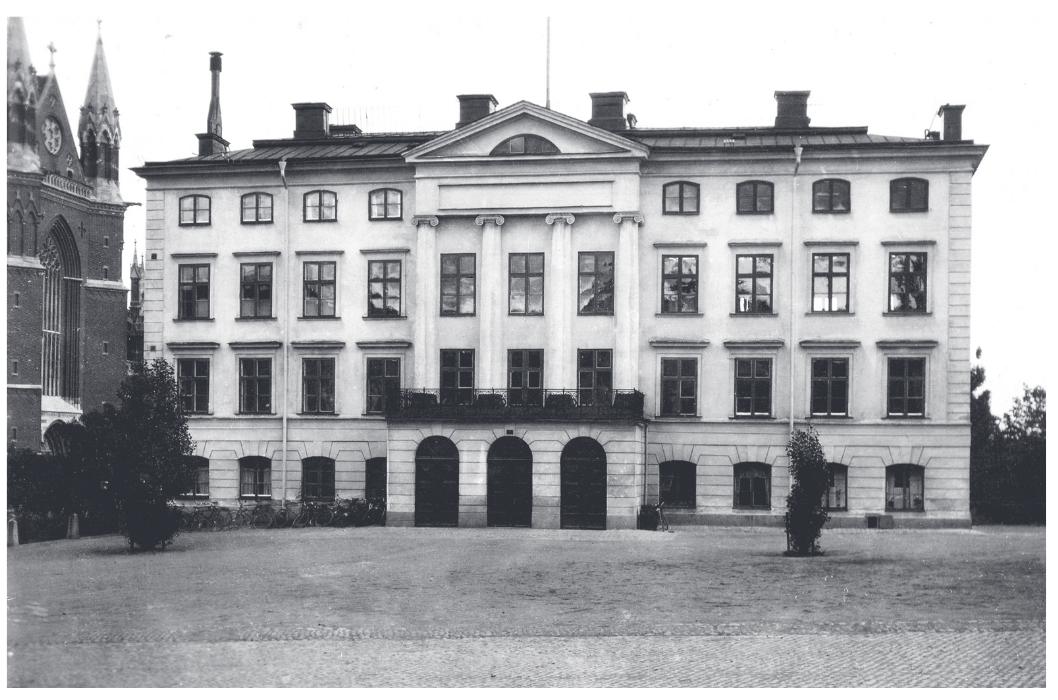
Above, Sweden’s “State Institute for Racial Biology” (Statens institut för rasbiologi), in central Uppsala. Located neighbouring the Uppsala cathedral (Domkyrka).
Other experimental inputs from Sweden beneficial to the racist ideology adopted by the Nazi, was the foundation of Europe’s first racial research academic institution.
It was founded by the Swedish government in Uppsala, in 1922, under the name “State Institute for Racial Biology” (Statens institut för rasbiologi).
It is commonly assumed that this ‘research’ institution was active in Sweden “only” until the late fifties –in any case this is rather a long time after the collapse of Hitler’s Third Reich.
In fact, the institution was only renamed, and has survived until present under the name of State Institute for Human Genetics (Institutionen för medicinisk genetik), now a department of Uppsala University. [17]
Nevertheless, the real main contribution from neutral Sweden for the implementation of Hitler’s Lebensraum in Europe, it came directly from the Swedish government and the industrial oligarchs profiting of the exports of weapon-related materials.
Swedish transporting of Nazi troops
The government of Sweden, comprised by a coalition of all political parties–with the exclusion of the communists– led by the Social Democrat Per Albin Hansson, permitted the transit through Sweden of over two million German troops during WW2.
The exact figure given by author María-Pía Boëthius is 2.140.000 troops. [18] The author has also demonstrated that it was not a transport of unarmed soldiers on leave back and forward from the frontlines to home in Germany. As, for instance, the weaponry was transported in separate wagons of the same trains.
Hitler’s troops were sent partly to occupied Norway, and partly to Finland during Operation Barbarossa –intended to the invasion of Russia (then Soviet Union).
Also weapons and artillery, tanks, etc. used the railways facilities provided by Sweden.
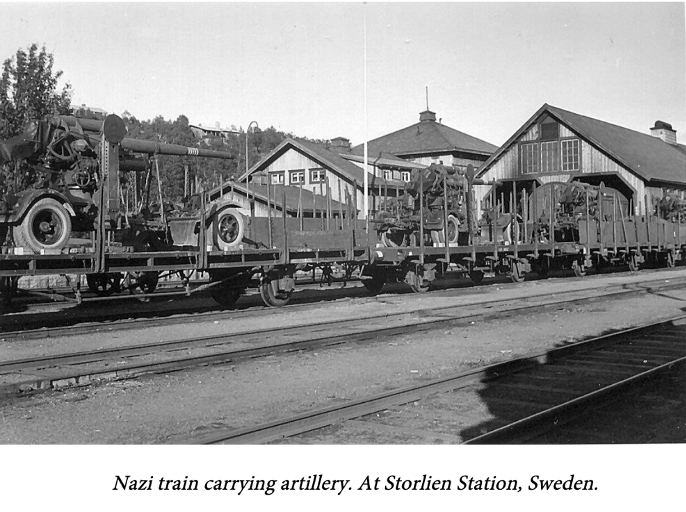
Sweden received payment by Germany for these services. In northern Sweden was established a warehouse system to allocate food and supplies for the German combating troops, and which were transported to the front by Swedish trucks operated by Swedish drivers. [18]
Sweden infringed international law when allowed Nazi Germany to use Swedish territory, the Swedish railways system and communications infrastructure for the transport of troops, ammunitions and supplies. [18]
The Hague Convention, §5 Art. 2 specifically prohibits that army personnel and material be transported across the territory of neutral countries.
Nazi Germany also obtained from neutral Sweden the right to use telecommunication system along the country, as well as the use of airports for the stopover of aircraft said to transport post to the front. [18]
One of these airports was Bromma, in Stockholm: the same airport used by the CIA when neutral Sweden authorized the secret renditions of political refugees living in Sweden, to be transported by CIA planes to torture centres elsewhere [issue treated in a separate section below].
German 163rd Infantry Division (Division Engelbrecht)
Eventually, a full division of 14.712 soldiers –the 163rd Infantry Division, or Division Engelbrecht– was transported by the Swedes from the Norway border to Finland in 1o6 trains [19] between 25 June and 12 July 1941. [20]
That makes around a 1.300 kilometres travelling, for which stopovers were arranged at several towns on the way where the soldiers would eat. [21] Swedish books, media and Internet sources report that the transport rout was between Charlottenberg (about 100 kilometres from Oslo) to Torneå (Tornio, in Finland). [22]
But in my review of sites which reproduce documents of the epoch, I could observe that the actual point of departure was instead Magnor, which is in Norway [See in next page a chart I worked out using a Google-map of the area].
The “Anteckningar” (protocols) of the agreement, reads:
“The gathering of the train-wagons and cargo loading takes place in Norway’s territory and the trains arriving from Magnor to Charlottenberg…” [23]
This finding would indicate that Sweden, in accepting the plan of the Germans, went all the way to Nazi-occupied Norway to fetch the German troops. This happened regularly on daily basis, with 6-8 trains per day, during the all transport period of the Engelbrecht Division to Finland.
Besides, the protocol-document I refer [23] mentions as signatories in the executive phase of the transport agreements, officers of both the German and the Swedish armies. A Swedish officer was on board of each of the trains transporting the troops.
“Attending from the part of Sweden’s Train System: Director, Major Wrede. From Germany: Major Stelzer and Captains Sasse and Neuman.”
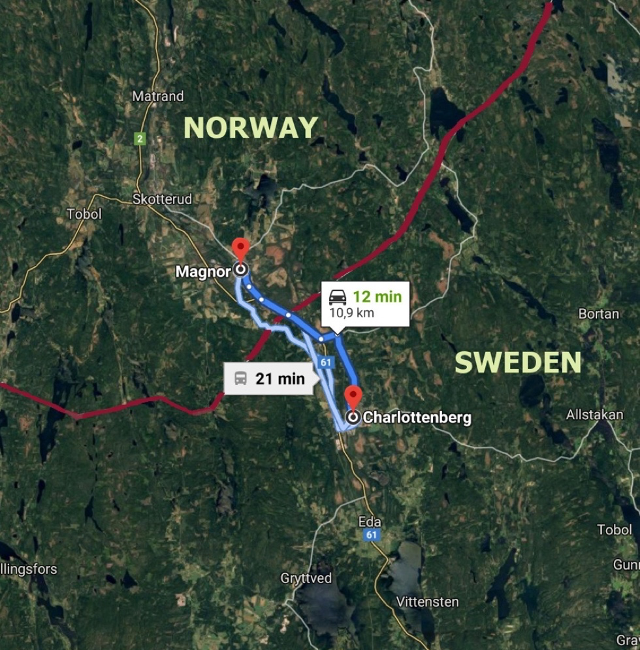
Also, several sources state that during the transport of the Engelbrecht Division troops, they were “escorted” [24] (or protected?) by 15.000 Swedish troops.
The 163rd Infantry Division Engelbrecht was fully equipped with weaponry, tanks, horses, etc.
And the reason why I give full details [25] [26] of the composition, armaments, combat gear, the regiments that formed part of the Engelbrecht Division, etc. [See Notes & References, down below] is because the enormity of the belligerent material, number of troops, etc. passing Sweden’s territory it makes
impossible a Swedish excuse, or a plausible juridical or ethics explanation regarding the severe infringements of international law as defined by the Haag Conventions.
This in turn invites to an explanation as to why Sweden was risking so much in doing what they did, in terms of the Swedish help to Hitler. A help that –as explicitly warned to Sweden by the allied forces –referring for example to Sweden’s supplies of iron and bearings to the German military industry–was determinant for Hitler to be able the continuation of the war operations.
Or why would Sweden indulge in such serious infringement of the neutrality status by transporting in its territory a full Infantry division, fully equipped, of nearly 15,ooo troops?
My answer is that it has primarily to do with the decision of Finland to joint Hitler’s military forces in the attack to the Soviet Union:
The Swedish government’s authorization to Hitler to let his troops passing over Sweden, and helping those troops passing over Sweden, it took place nearly immediately after that Finland joined Germany forces for the attack to Russia.
It was the Swedish way of also participating in Operation Barbarossa against Russia. It was not because of an invasion threat from Hitler, which never existed. [27] [See further below Ideological or geopolitical motivations].
SS Totenkopk
The reader must have heard of the SS Totenkopk troops, the Nazi military elite forces used as guards in the concentration camps. Even ignored over years by the public –because the government of Sweden had kept it in secret for decades– is that on 4 October 1940, over thousand troops of the SS-division Totenkopk disembarked with Swedish authorization in the northern port of Luleå in order to continue by train to Narvik, to assist the Nazi occupation of Norway.
The SS troops, consisting of a battalion of the regiment (Totenkopfstandarte) Kirkenes, had arrived to Luleå in the German ship [29]
Trade
It should be noted that over 90 percent of the Swedish trade during the first years of the Second World War –when Hitler war machine was strongest– was done with Germany. [28]
Neutral Sweden also provided Hitler with iron ore to be used in the fabrication of tanks, weapons, etc. The provision of Swedish iron ore, was vital for the German military industry.
Germany received from Sweden 10.6 millions ton of iron ore per year. In 1941, were daily transported from Sweden to Germany 145.000 tons of iron ore. [30]
The Wallenberg’s factories manufacturing bearings supplied those vital components for German tanks and aeroplanes.
The allies forces, particularly England issued protests on the volume of that trade. Eventually , as María-Pía Boëthius exposed in her book “Heder och Sambete”, a variety of products, or certain quantities of the export items, were smuggled from Sweden to Germany. [31]
Swedish banks, particularly Wallenberg’s Stockholm Enkilda Banken contributed in placing assets that have been plundered by the Nazis in the occupied territories of Europe or from the Jews. [32]
Notes and references
[13] Carl von Clausewitz , “On War”. Berlin: Dümmlers Verlag, 1832. English translation:
http://www.gutenberg.org/files/1946/1946-h/1946-h.htm#chap01. See Chapter I, Section 24.
[14] For example, I was quoting General Clausewitz back in 1965, in a work co-authored together with Miguel Enríquez and his brother Marco Antonio: “Tesis Político-Militar” –also known as “La Tesis Insurrecional”– approved in the Foundation Congress of the Movement of the Revolutionary Left, MIR. Eventually, MIR was defeated a decade later by the Pinochet military forces. Miguel died in combat. See a) Jose L. Calderon Lopez. “La política del Movimiento de Izquierda Revolucionaria (MIR) durante los dos primeros años de la Dictadura Militar”. Universidad de Santiago, Chile, Departamento de Historia. b) Pedro A. Valdés Navarro , “Elementos teóricos en la formación y desarrollo del MIR durante el período 1965-1970“. University of Valparaíso.
[15] M Ferrada de Noli. “Assange and WikiLeaks have NOT caused the deterioration of Sweden’s international prestige. This is done by Swedes themselves”. The Professors’ Blog, 15 June 2012.
[16] Kjellén, Rudolf. [1916] 1917. Der Staat als Lebensform. Leipzig: S. Hirzel.
[17] The archives of the State Institute for Racial Biology. (Retrieved 15 December 2019).
[18] Maria Pia Boëthius, “Heder och Sambete. Sverige och andra världskriget”. Ordfront Förlag, 1999. page 54.
[19] SVT, “70 år sedan tysktågen rullade genom Sverige“, 11 July 2011.
[20] Blenda W. Thor, “Engekbrechtdivisionen”. Blog.
[21] These posts were Kil, Laxå, Krylbo, Bollnäs, Ånge, Helgum, Vännäs, Jörn och Boden södra, according to information attributed to former officer and investigator Erik Carlsson. In: “Division Engelbrechts väg enligt källa”,
Järnvägshistoriskt forum , 22 January 2013. (Retrieved 15 December 2019).
[22] In: “Division Engelbrechts väg Del 1”, Järnvägshistoriskt forum, 22 January 2013. (Retrieved 15 December 2019).
[23] In: “Division Engelbrechts väg Del 1”, Järnvägshistoriskt forum, 22 January 2013. (Retrieved 15 December 2019).
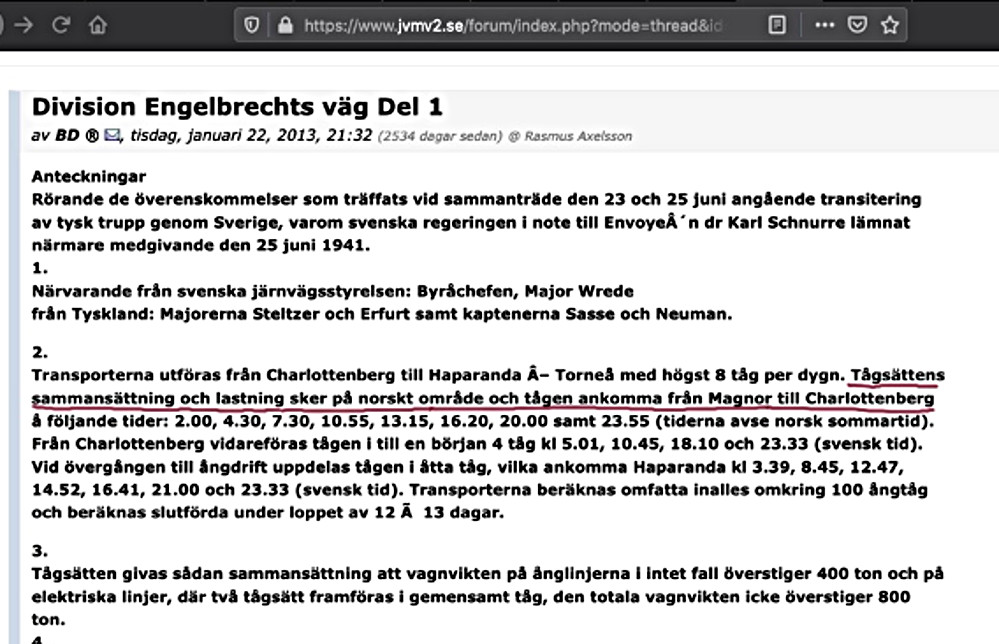
“The gathering of the train-wagons and cargo loading takes place in Norway’s territory and the trains arriving from Magnor to Charlottenberg…”
“Attending from the part of Sweden’s Train System: Director, Major Wrede.
From Germany: Major Stelzer and Captains Sasse and Neuman.”
[24] Christian Leitz, “Nazi Germany and Neutral Europe during the Second World War”. Manchester University Press, 2011. Page 56.
[25] According to Axis History (retrieved 15 December 2019): the 163rd Infantry Division comprised:
Reichswehr Rifle Regiment 59
Reichswehr Rifle Regiment 60
Reichswehr Hunter Btl. 30
Reichswehr Cavalry Regiment 30
Reichswehr Cavalry Regiment 130
light Reichswehr artillery regiment 3
[26] According to Wikipedia (retrieved 19 December 2019): the 163rd Infantry Division comprised:
Headquarters
307th Infantry Regiment
310th Infantry Regiment
324th Infantry Regiment
234th Artillery Regiment
234th Reconnaissance Battalion
234th Tank Destroyer Battalion
234th Engineer Battalion
234th Signal Battalion
234th Field Replacement Battalion
234th Divisional Supply Group
[27] “Hitler hotade inte att ockupera Sverige”. Aftonbladet, 25 June 2016.
[28] Maria Pia Boëthius, op.cit. Page 15.
[29] Maria Pia Boëthius, op.cit. page 128.
[30] Maria Pia Boëthius, op.cit.
[31] Gerard Aalders & Wiebes Cees, “The art of cloaking ownership: the secret collaboration and protection of the German war industry by the neutrals: the case of Sweden”. Amsterdam University Press, 1996.
[32] Sweden and Jewish Assets – Government Offices of Sweden
This text forms part of the book “Sweden’s Geopolitical Case Against Assange 2010-2019“. ©Libertarian Books, Sweden, 2020.
